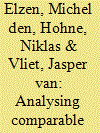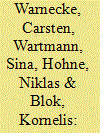|
|
|
Sort Order |
|
|
|
Items / Page
|
|
|
|
|
|
|
| Srl | Item |
| 1 |
ID:
091698


|
|
|
|
|
| Publication |
2009.
|
| Summary/Abstract |
EU Heads of State and Government agreed in March 2007 that the EU will reduce its greenhouse gas emissions to 30% below 1990 levels by 2020 within an international post-2012 climate agreement, provided that other developed (Annex I) countries commit to comparable reductions. Within this context, this paper first explores the pros and cons of many possible conceptual approaches to assess the comparability of the mitigation efforts by Annex I countries. We selected six approaches for further analysis, which represent efforts well and are technically feasible. The implications of each of these six approaches were analysed in terms of the reductions and abatement costs that must be made by different Annex I countries to meet an aggregate reduction of 20% and 30%, respectively, below 1990 levels by 2020. The analysis indicates that significant reductions are necessary for all developed countries. This study shows that reductions by the EU of at least 30%, combined with comparable reduction efforts by other developed countries to meet the aggregate Annex I reduction target of 30% by 2020 and support of developed countries for developing countries to keep their emissions 15-30% below the baseline, are sufficient to achieve the EU climate goal of 2 °C.
|
|
|
|
|
|
|
|
|
|
|
|
|
|
|
|
| 2 |
ID:
128441


|
|
|
|
|
| Publication |
2014.
|
| Summary/Abstract |
Many of the major greenhouse gas emitting countries have planned and/or implemented domestic mitigation policies, such as carbon taxes, feed-in tariffs, or standards. This study analyses whether the most effective national climate and energy policies are sufficient to stay on track for meeting the emission reduction proposals (pledges) that countries made for 2020. The analysis shows that domestic policies of India, China and Russia are projected to lead to lower emission levels than the pledged levels. Australia's and the EU's nationally legally binding policy framework is likely to deliver their unconditional pledges, but not the conditional ones. The situation is rather unclear for Japan, South Korea, Brazil and Indonesia. We project that policies of Canada and the USA will reduce 2020 emission levels, but additional policies are probably needed to deliver their pledges in full. The analysis also shows that countries are implementing policies or targets in various areas to a varying degree: all major countries have set renewable energy targets; many have recently implemented efficiency standards for cars, and new emission trading systems are emerging.
|
|
|
|
|
|
|
|
|
|
|
|
|
|
|
|
| 3 |
ID:
133215


|
|
|
|
|
| Publication |
2014.
|
| Summary/Abstract |
The current project-based carbon market mechanisms such as the Clean Development Mechanism (CDM) and the Joint Implementation (JI) do not have a direct impact on global greenhouse gas emission levels, because they only replace or offset emissions. Nor do they contribute to host country×s national greenhouse gas emission reduction targets. Contributions to net emission reductions in host countries is likely to become mandatory in new mechanisms under development such as in the framework for various approaches, a new market-based mechanism and even in a reformed JI. This research analysed the question if approaches for carbon market-based mechanisms exist that allow the generation of net emission reductions in host countries while keeping project initiation attractive. We present a criteria-based assessment method and apply it for four generic options in existing mechanisms and derive implications for future mechanism frameworks. We identified the application of "discounts" on the amount of avoided emissions for the issuance of carbon credits and "standardisation below business as usual" as most promising options over "limiting the crediting period" and "over-conservativeness". We propose to apply these options differentiated over project types based on internal rate of return to ensure cost-efficiency and attractiveness.
|
|
|
|
|
|
|
|
|
|
|
|
|
|
|
|
|
|
|
|
|